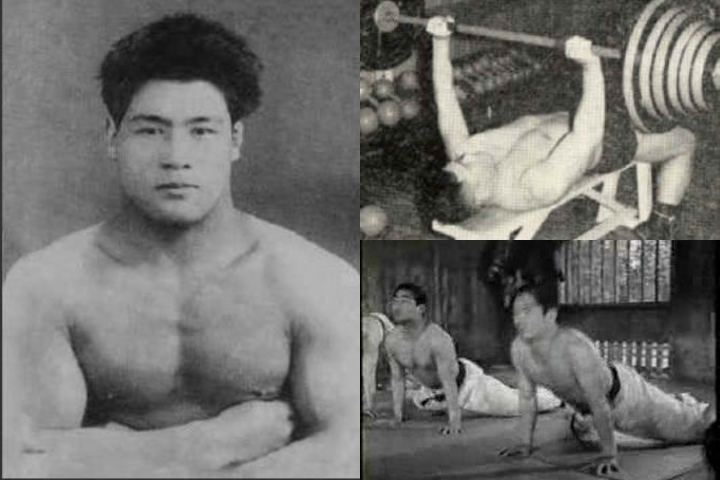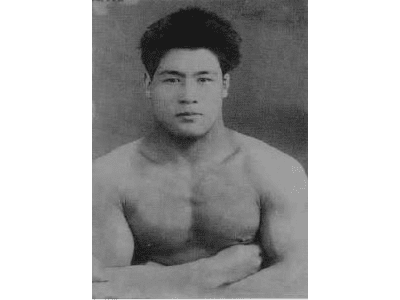Nationality Japanese Weight 84 kg Height 1.7 m | Name Masahiko Kimura Style Judo | |
 | ||
Born September 10, 1917Kumamoto, Japan ( 1917-09-10 ) Similar People | ||
Masahiko kimura judo techniques
Masahiko Kimura (木村 政彦, Kimura Masahiko, September 10, 1917 – April 18, 1993) was a Japanese judoka and professional wrestler who is widely considered one of the greatest judoka of all time. In submission grappling, the reverse ude-garami arm lock is often called the "Kimura", due to his famous victory over Gracie jiu-jitsu developer Hélio Gracie. In the Japanese professional wrestling world, he is known for the controversial match he had with Rikidōzan.
Contents
- Masahiko kimura judo techniques
- Kosen judo volume 1 by masahiko kimura
- Biography
- Kimura vs Hlio Gracie
- Kimura in professional wrestling
- Kimura vs Valdemar Santana
- Death
- Achievements
- References

Kosen judo volume 1 by masahiko kimura
Biography

Kimura was born on September 10, 1917 in Kumamoto, Japan. Masahiko Kimura began training Judo at age of 9 and was promoted to yondan (4th dan) at the age of 15 after six years of Judo. He had defeated six opponents (who were all 3rd and 4th dan) in a row. In 1935 at age 18 he became the youngest ever godan (5th degree black belt) when he defeated eight consecutive opponents at Kodokan (headquarters for the main governing body of Judo).

Kimura's remarkable success can in part be attributed to his fanatical training regimen, managed by his teacher, Tatsukuma Ushijima. Kimura reportedly lost only four judo matches in his lifetime, all occurring in 1935. He considered quitting judo after those losses, but through the encouragement of friends he began training again. He consistently practiced the leg throw osoto gari (large outer reap) against a tree. Daily randori or sparring sessions at Tokyo Police and Kodokan dojos resulted in numerous opponents suffering from concussions and losing consciousness. Many opponents asked Kimura not to use his osoto gari.

At the height of his career Kimura's training involved a thousand push-ups and nine-hours practice every day. He was promoted to 7th dan at age 30, a rank that was frozen after disputes with Kodokan over becoming a professional wrestler, refusing to return the All Japan Judo Championship flag, and issuing dan ranks while in Brazil.
Kimura also entered Karate in his pursuit of martial arts, believing that karate would strengthen his hands. First he trained what today is known as Shotokan Karate under its founder Gichin Funakoshi for two years, but eventually switched to training Goju-Ryu Karate under So-Nei Chu (a pupil of Goju-ryu karate founder Chojun Miyagi) and finally became an assistant instructor, along with Gogen Yamaguchi and Masutatsu Oyama in his dojo (the latter also going to university together with him and Aikido master Gozo Shioda). In his Autobiography, Kimura attributes the use of the makiwara (a karate training implement) as taught to him by So Neichu and his friend and training partner Masutatsu Oyama, as being a significant contributor to his consequent tournament success. He began using the makiwara daily prior to his first All Japan success and never lost another competition bout.
Kimura vs. Hélio Gracie
In 1949, after touring for Hawaii, Kimura and his troupe formed by judoka Toshio Yamaguchi and Yukio Kato went to Brazil after an invitation by the Sao Paulo Shimbun. There they were challenged by Hélio Gracie of the Gracie Jiu Jitsu. Gracie proposed a match under what would be known as the "Gracie Rules", in which throws and pins would not count towards victory, with only submission or loss of consciousness. This played against judo rules in which pins and throws can award someone a victory, but they accepted nonetheless. Kato was the first to accept the challenge, drawing with Hélio Gracie in their match at the Maracana stadium. However, he lost to Gracie by gi choke in the rematch at the Ibirapuera in Sao Paulo. Hélio proposed to continue with the challenge, and Yamaguchi appointed himself the next to fight. Kimura, however, volunteered to fight in his place. The bout between Gracie and Kimura took place again in the Maracana stadium, before an audience of 20,000 people, including president of Brazil Getúlio Vargas. Expectation was such that, according to a source, Kimura had been warned by the Japanese embassy that he would not be welcomed back in Japan if he lost the match. Kimura was received in the arena with raw eggs and insults by the Brazilian crowds, and the Gracie challengers brought a coffin to symbolize Kimura would be dead, just like they had done with Kato. At the start of the match, Hélio tried to throw him down with osoto gari and ouchi gari, but Kimura blocked them and scored multiple throws by ouchi gari, harai goshi, uchi mata and ippon seoi nage. However, Helio Gracie was able to perform ukemi thanks to the soft mat used in competitions, so Kimura couldn't subdue him by throwing alone. The judoka started planning a way to win between throw and throw, and at the second round he took the fight to the ground, pinning Gracie with kuzure-kami-shiho-gatame. After a number of holds by the Japanese, including kesa-gatame, sankaku-jime and do-jime, the Brazilian looked unable to breathe under Kimura, but he persevered, until he tried to switch position by pushing with his arm. At that moment, Kimura seized the limb and executed gyaku-ude-garami. Hélio did not surrender, and Kimura rotated the arm until it broke. As Gracie still refused to give up, Masahiko twisted the arm further and broke it again. Finally, when the judoka was about to twist it a third time, Gracie's corner threw the towel, and Kimura was declared winner. A crowd of Japanese came and tossed Kimura high in celebration, while Hélio's arm was treated by doctors. As a tribute to Kimura's victory, the armlock technique he used to defeat Gracie has since been commonly referred to as the Kimura lock, or simply the Kimura, in Brazilian Jiu-Jitsu and, more recently, mixed martial arts circles.
Kimura in professional wrestling
In the early 1950s, Kimura founded Kokusai Pro Wrestling Association. He was also invited by Rikidōzan to compete as a professional wrestler in his Japan Pro Wrestling Association. They performed both as tag team partners and as opponents, but Kimura was not marketed or publicized as much as Rikidōzan. The Rikidōzan vs. Kimura match for the Japanese Professional Wrestling Heavyweight title was the first high-profile match, but, according to Kimura, it didn't go as planned, being one of the earliest examples of a shoot in professional wrestling.
The match was supposed to go to a draw and set up a series of rematches, but they never happened. During its course, in a spot in which Kimura would let Rikidōzan strike him with a karate chop in the chest, Rikidōzan broke the script and attacked Kimura for real, striking him in the neck instead and using full force. According to the judoka, the chop hit his neck arteries and he was rendered unconscious, while his opponent started to kick him on the ground. Rikidōzan won the match by knockout, and Kimura never received a rematch.
On December 8, 1963, while partying in a Tokyo nightclub, Rikidōzan was stabbed with a urine-soaked blade by gangster Katsuji Murata who belonged to the ninkyō dantai Sumiyoshi-ikka. He died a week later of peritonitis on December 15. Kimura's participation in the incident was suspected, as he is quoted in his autobiography as saying: "I could not forgive his treachery. That night, I received a phone call informing me that several ten yakuza are on their way to Tokyo to kill Rikidozan." However, Japanese author Toshiya Masuda would release in 2011 the book Why Kimura Didn't Kill Rikidozan, in which this theory is dismissed.
Kimura formed International Pro Wrestling Force (IPWF), a promotion based in his hometown of Kumamoto, as a local affiliate of The Japan Wrestling Association (JWA). Although JWA later took over operations, IPWF is remembered for being the first Japanese promotion to introduce Mexican Lucha Libre wrestlers.
Some biographers note that his professional wrestling career began shortly after his wife was diagnosed with tuberculosis, and it is speculated by some that he began professional wrestling to pay for her medication. Indeed, the predicament was likely beyond the financial means of a police instructor, which was his paying job prior to professional wrestling.
In the Korean film about Rikidozan released in 2004, Kimura is portrayed by Masakatsu Funaki but his surname is written Imura rather than Kimura.
Kimura vs. Valdemar Santana
Kimura went to Brazil again in 1959 to conduct his last professional wrestling tour, and he was challenged by Valdemar Santana to a "real" (not choreographed) submission match. Santana, a champion in Gracie Jiu Jitsu and capoeira, was 27 years old, 6 feet tall, and weighed 205 lb, 40 lbs more than Masahiko. He had fought Hélio Gracie and won by knockout, with the fight lasting more than three hours. His match with Kimura was brief, with the judoka throwing Santana with seoi nage, hane goshi and osoto gari before applying his famous gyaku-ude-garami, making him give up.
Santana requested a rematch under vale tudo rules, and this time the bout lasted 40 minutes. It would be considered by Kimura as one of his hardest fights ever, as he was ill and injured at the time of the match, and promoters supposedly threatened him with police presence in order to compel him to fight against his doctor's orders. Kimura and Santana started trading strikes, and the capoeirista soon showed his superiority on this field, damaging Masahiko with high kicks and open-handed strikes. The judoka headbutted him in the abdomen and tried to throw him down, only for Valdemar to answer with another headbutt. Kimura tried to execute ippon seoi nage, but he slipped and fell to the ground, where Santana started striking him with punches and headbutts, but the judoka caught him in the momentum of a headbutt and broke his nose with a punch from the bottom. The competitors, both tired and bleeding, disengaged and returned to standing, where they continued exchanging strikes until the clock marked the end of the match.
Death
Kimura died on April 18, 1993, after a long battle with lung cancer. He was 75 years old.
